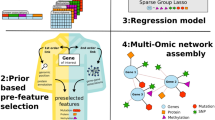Abstract
Analysis of NGS and other sequencing data, gene variants, gene expression, proteomics, and other high-throughput (OMICs) data is challenging because of its biological complexity and high level of technical and biological noise. One way to deal with both problems is to perform analysis with a high fidelity annotated knowledgebase of protein interactions, pathways, and functional ontologies. This knowledgebase has to be structured in a computer-readable format and must include software tools for managing experimental data, analysis, and reporting. Here, we present MetaCore™ and Key Pathway Advisor (KPA), an integrated platform for functional data analysis. On the content side, MetaCore and KPA encompass a comprehensive database of molecular interactions of different types, pathways, network models, and ten functional ontologies covering human, mouse, and rat genes. The analytical toolkit includes tools for gene/protein list enrichment analysis, statistical “interactome” tool for the identification of over- and under-connected proteins in the dataset, and a biological network analysis module made up of network generation algorithms and filters. The suite also features Advanced Search, an application for combinatorial search of the database content, as well as a Java-based tool called Pathway Map Creator for drawing and editing custom pathway maps. Applications of MetaCore and KPA include molecular mode of action of disease research, identification of potential biomarkers and drug targets, pathway hypothesis generation, analysis of biological effects for novel small molecule compounds and clinical applications (analysis of large cohorts of patients, and translational and personalized medicine).
Access this chapter
Tax calculation will be finalised at checkout
Purchases are for personal use only
Similar content being viewed by others
References
Salwinski L, Eisenberg D (2003) Computational methods of analysis of protein–protein interactions. Curr Opin Struct Biol 13:377–382
Kemmeren P et al (2002) Protein interaction verification and functional annotation by integrated analysis of genome-scale data. Mol Cell 9:1133–1143
Ceccarelli M, Barthel FP et al (2016) Molecular profiling reveals biologically discrete subsets and pathways of progression in diffuse glioma. Cell 164(3):550–563
The Cancer Genome Atlas Network (2015) The molecular taxonomy of primary prostate cancer. Cell 163(4):1011–1025
The Cancer Genome Atlas Network (2015) Comprehensive molecular characterization of papillary renal cell carcinoma. N Engl J Med 374(2):135–145
Ciriello G, Gatza ML et al (2015) Comprehensive molecular portraits of invasive lobular breast cancer. Cell 163(2):506–519
Khatri P, Sirota M, Butte AJ (2012) Ten years of pathway analysis: current approaches and outstanding challenges. PLoS Comput Biol 8(2):e1002375
Jin L, Zuo X-Y, Su W-Y et al (2014) Pathway-based analysis tools for complex diseases: a review. Genomics Proteomics Bioinformatics 12(5):210–220
Yook SH, Oltvai ZN, Barabási AL (2004) Functional and topological characterization of protein interaction networks. Proteomics 4(4):928–922
Barabasi AL, Oltvai Z (2004) Network biology: understanding the cell’s functional organization. Nat Rev Genet 5(2):101–113
Bader S, Kühner S, Gavin AC (2008) Interaction networks for systems biology. FEBS Lett 582(8):1220–1224
Nitsch D, Gonçalves JP, Ojeda F, de Moor B, Moreau Y (2010) Candidate gene prioritization by network analysis of differential expression using machine learning approaches. BMC Bioinformatics 11:460
Hsu C-L, Huang Y-H, Hsu C-T, Yang U-C (2011) Prioritizing disease candidate genes by a gene interconnectedness-based approach. BMC Genomics 12(Suppl 3):S25
Köhler S, Bauer S, Horn D, Robinson PN (2008) Walking the interactome for prioritization of candidate disease genes. Am J Hum Genet 82(4):949–958
Vanunu O, Magger O, Ruppin E, Shlomi T, Sharan R (2010) Associating genes and protein complexes with disease via network propagation. PLoS Comput Biol 6(1):e1000641
Chen J, Aronow BJ, Jegga AG (2009) Disease candidate gene identification and prioritization using protein interaction networks. BMC Bioinformatics 10:73
Chindelevitch L, Ziemek D, Enayetallah A et al (2012) Causal reasoning on biological networks: interpreting transcriptional changes. Bioinformatics 28:1114–1121
Li X, Shen L, Shang X, Liu W (2015) Subpathway analysis based on signaling-pathway impact analysis of signaling pathway. PLoS One 10(7):e0132813
Ulitsky I, Krishnamurthy A, Karp RM, Shamir R (2010) DEGAS: de novo discovery of dysregulated pathways in human diseases. PLoS One 5(10):e13367
Leiserson MDM, Vandin F, Wu H-T et al (2015) Pan-cancer network analysis identifies combinations of rare somatic mutations across pathways and protein complexes. Nat Genet 47(2):106–114
Hendrix W, Rocha AM, Padmanabhan K et al (2011) DENSE: efficient and prior knowledge-driven discovery of phenotype-associated protein functional modules. BMC Syst Biol 5:172
Shannon P, Markiel A et al (2003) Cytoscape: a software environment for integrated models of biomolecular interaction networks. Genome Res 13(11):2498–2504
Paull EO, Carlin DE, Niepel M et al (2013) Discovering causal pathways linking genomic events to transcriptional states using tied diffusion through interacting events (TieDIE). Bioinformatics 29(21):2757–2764
Suthram S, Beyer A, Karp RM, Eldar Y, Ideker T (2008) eQED: an efficient method for interpreting eQTL associations using protein networks. Mol Syst Biol 4:162
Vaske CJ, Benz SC, Sanborn JZ et al (2010) Inference of patient-specific pathway activities from multi-dimensional cancer genomics data using PARADIGM. Bioinformatics 26(12):i237–i245
Purcell S et al (2007) PLINK: a tool set for whole-genome association and population-based linkage analyses. Am J Hum Genet 81(3):559–575
Pollard J Jr, Butte AJ, Hoberman S, Joshi M, Levy J, Pappo J (2005) A computational model to define the molecular causes of type 2 diabetes mellitus. Diabetes Technol Ther 7(2):323–336
Author information
Authors and Affiliations
Corresponding author
Editor information
Editors and Affiliations
Rights and permissions
Copyright information
© 2017 Springer Science+Business Media LLC
About this protocol
Cite this protocol
Dubovenko, A., Nikolsky, Y., Rakhmatulin, E., Nikolskaya, T. (2017). Functional Analysis of OMICs Data and Small Molecule Compounds in an Integrated “Knowledge-Based” Platform. In: Tatarinova, T., Nikolsky, Y. (eds) Biological Networks and Pathway Analysis. Methods in Molecular Biology, vol 1613. Humana Press, New York, NY. https://doi.org/10.1007/978-1-4939-7027-8_6
Download citation
DOI: https://doi.org/10.1007/978-1-4939-7027-8_6
Published:
Publisher Name: Humana Press, New York, NY
Print ISBN: 978-1-4939-7025-4
Online ISBN: 978-1-4939-7027-8
eBook Packages: Springer Protocols




